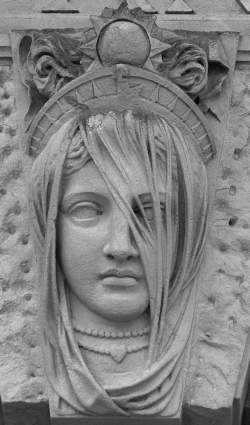
Burlington House, home of the Royal Academy and various other learned institutions, was built in the 17th Century, and refaced in the early 18th Century by Colin Campbell to make it Palladian. Samuel Ware remodelled it again in the 1810s, mostly inside, and in the 1860s through to the 1870s, Robert Richardson Banks and Charles Barry put it in the state we see it today. Facing onto Piccadilly, Banks and Barry added the front range, with high triple-archway, and seven bays to each side. All very Italianate. At the time it was built, the archway was thought to be the ‘largest archway of the sort in London, being 20ft clear in width and abou 32ft in height. The façade of Burlington House is fully seen from Piccadilly through this archway…’. Banks and Barry also did the wings on the left and right of the internal courtyard, housing the Chemical Society, Linnean Society etc, again in Italian vein. Sydney Smirke, also working in the 1870s, redid the frontage of the original block, increasing the height of the building and adding a frontal arcade.
The exterior sculpture dates then from the 1870s. On the main frontage of Burlington House are standing figures of great artists and architects as follows:
Beneath these on the arcade, several keystone heads, and a few more are above arches around the courtyard. Along with several bearded warriors and priests, one of which is an Assyrian and another a Pharaoh, they include a Roman girl wearing a lionskin, a Greek girl symbolic of peace, with crown of olive leaves, a dove and, oddly, acorn earrings and, and best of all, a veiled girl in the style made popular by Italian sculptors (if you like these keystones, there is a keystones page here).

The front archway has four spandrel groups, two inside, two outside, each showing an elegant emblematic girl, accompanied by one or more cherubs. Good work, which I believe to be by the excellent and prolific Birnie Philip. On the outside, to the left, perhaps Literature, more likely Knowledge (see end of this page for picture, and note on allegorical figures with this subject), holding a scroll and book, a swan behind – could this be rather a Leda and the swan? – it would be in the sense of her engendering of beauty (Helen of Troy). The right hand spandrel is clearer – she is clearly emblematic of the Sciences, holding a telescope and set square, her cherub looking at a globe, a snake behind her other shoulder, symbol of medicine.
On the interior of the gate, the left hand figure, the most beautiful of the four, has her back to us for compositional reasons, and looks at us over her shoulder. She is some creature of the heavens, having a foot on the moon, and being accompanied as well as by her two cherubs, a further winged figure with a butterfly on her head, and a winged globe. A hatching egg and a pepper may also be spotted by the sharp sighted. Perhaps Heavenly Inspiration? Finally, the fourth figure is most clear as the Arts – the girl herself holds nothing, but looks at the image of a nude on a shield held by a cherub with a sculptor’s mallet, resting on top of a pillar (architecture); the other cherub has palette and musical instruments, and a large decorated pot. All in the best possible taste.
In the centre of the courtyard, though often accompanied by some modern work associated with the Summer Exhibition, is a bronze statue of Sir Joshua Reynolds, first President of the Royal Academy, by Alfred Drury. Rather mannered, and not among my favourite works by Drury.
If not going to a paid-for show, you should at least visit the free bit of the interior, which has four rooms of the old Burlington House, with decorated ceilings, fireplaces, and a small, changing display of works from the Academy’s own collection, including one room usually with woodcuts and engravings.
Exit the building, and to see the rear side, go through Burlington Arcade, just to the left. Burlington Arcade was built by Samuel Ware in 1818/19, and somewhat altered in the early 20th Century by Beresford Pite, who added two big busts or steles, male and female on big brackets to the side, and a triple-arched arcade above on columns, rather echoing the original ground floor level frontage. The two busts, it has to be said, are somewhat hideous, with a grotesque twist to the neck; better are the very small figures to either side of the keystone position, rather recessed, showing a man and a woman, each with an infant. Far above, a shield with flanking stag and dog. Almost opposite, Piccadilly Arcade (1909/10), with no sculptural interest.
Anyhow, as said, proceeding through Burlington Arcade leads to the rear of Burlington House, now part of the Academy, previously the Museum of Mankind, and in the 1870s, when it got its sculptural decoration, owned by the Government. There are more than a score of statues here:
Walk along Piccadilly // West to Berkeley Square
Visits to this page from 13 Mar 2014: 12,430